Thailand Street Food: Eat Safely & Authentically!
You’ve probably heard that street food in Thailand is a culinary experience like no other. With over 2.7 million vendors across the country, it’s a big part of Thai culture. It offers a wide range of dishes that excite the taste buds.

As you walk through the busy streets, the smells and tastes are amazing. But, with some tips, you can enjoy Thai food safely and authentically. Knowing the local culture, being careful, and trying the most popular dishes are important for a great time.
Exploring Thai street food lets you enjoy amazing flavours and learn about the country’s food history. It’s a way to truly experience Thai culture.
An Introduction to Thailand Street Food Culture
Exploring Thailand, you’ll find that street food is more than food. It’s a way to experience the culture, meet vendors, and enjoy the atmosphere. Thai street food shows the country’s rich food history, shaped by its past, geography, and traditions.
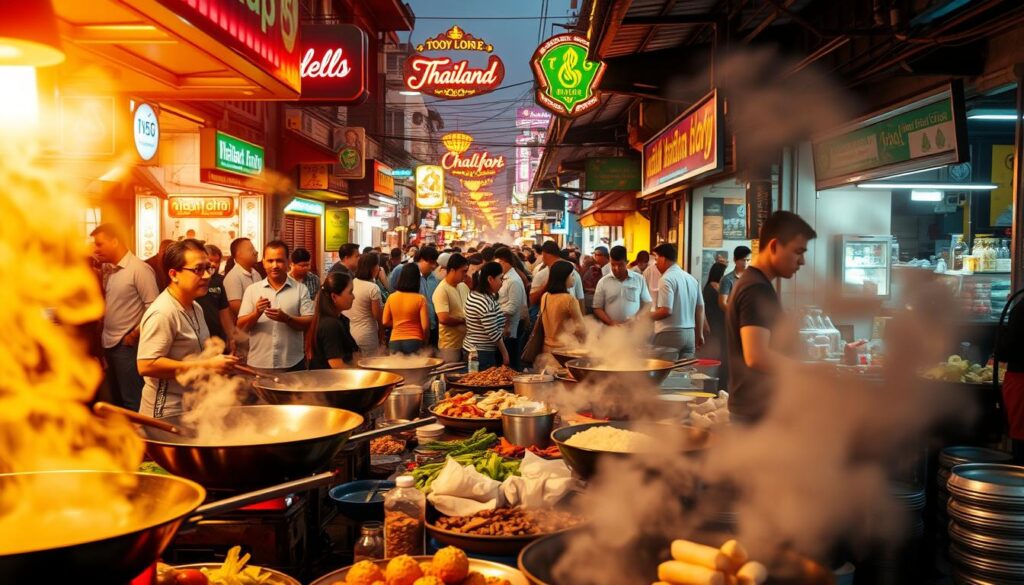
What Makes Thai Street Food Unique?
Thai street food is special because of its freshness and variety. Meals are made right in front of you, ensuring they’re at their best. You can try everything from spicy tom yum soup to fragrant pad thai. The dishes are full of fresh herbs, chilies, and more, making them rich and complex.
The way food is prepared also makes Thai street food unique. Vendors have honed their recipes over years, learning from their families. This hard work means their dishes are not just tasty but also true to their roots.
The Role of Street Food in Thai Society
Street food is key in Thai society, acting as a place where people come together. Locals and visitors enjoy meals at street stalls, creating a vibrant and friendly scene.
Street food is a big part of daily life in Thailand. It’s a quick and affordable way for many to eat. The love for street food has also led to the growth of markets and night markets. These places offer a wide variety of dishes and snacks.
- Street food brings people together, fostering a sense of community.
- It’s a reflection of Thai culture and traditions.
- The variety of dishes available caters to different tastes and dietary preferences.
Must-Try Thai Street Food Dishes
Exploring Thailand’s streets reveals a world of flavours. Thai street food offers a variety of dishes, each with its own taste and cooking method.
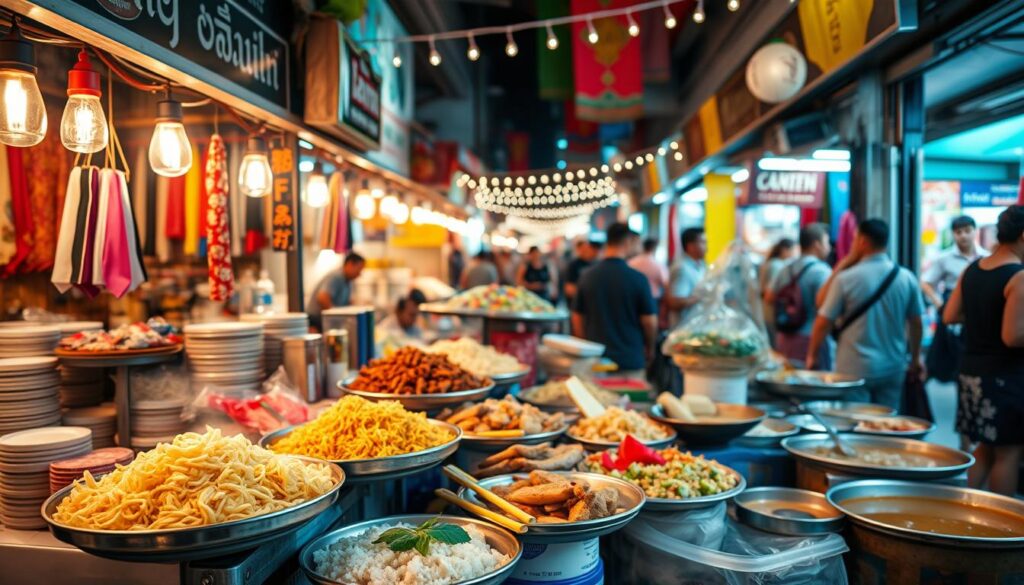
Pad Thai: The Classic Noodle Dish
Pad Thai is famous worldwide. It’s a stir-fried noodle dish with rice noodles, eggs, tofu, and veggies. It’s cooked with a mix of Thai spices.
The dish’s sweet, sour, and savoury flavours are irresistible. You can find it at almost every street food stall. Vendors often add their own special touch.
Som Tum: Spicy Green Papaya Salad
Som Tum, or spicy green papaya salad, is perfect for spice lovers. It’s made with shredded green papaya, tomatoes, chilies, and peanuts. It’s mixed with a sour and spicy dressing.
Som Tum is refreshing and invigorating. The spiciness can vary. So, it’s good to ask your vendor to adjust it to your liking.
Moo Pad Krapow: Basil Stir-Fried Pork
Moo Pad Krapow, or basil stir-fried pork, is a favourite. It’s made with minced pork, Thai basil, chilies, and spices. All are stir-fried together for a fragrant and spicy dish.
It’s often served with steamed rice. Moo Pad Krapow is a hearty meal that’s hard to resist. Its mix of textures and flavours makes it a highlight of Thai street food.
Finding the Best Street Food in Thailand
Exploring Thailand reveals a world of flavors through its street food. To enjoy the best Thai dishes, knowing where to find them is key.
Bustling Markets Worth Exploring
Thailand boasts many bustling markets filled with street food. These markets are cultural centers where locals and visitors share authentic Thai tastes. Famous spots include Bangkok’s Chatuchak Weekend Market and Chiang Mai’s Night Bazaar.
These markets serve a variety of dishes, from noodle soups to spicy snacks. Exploring these markets is a must for any street food enthusiast. They offer a chance to try many local dishes.
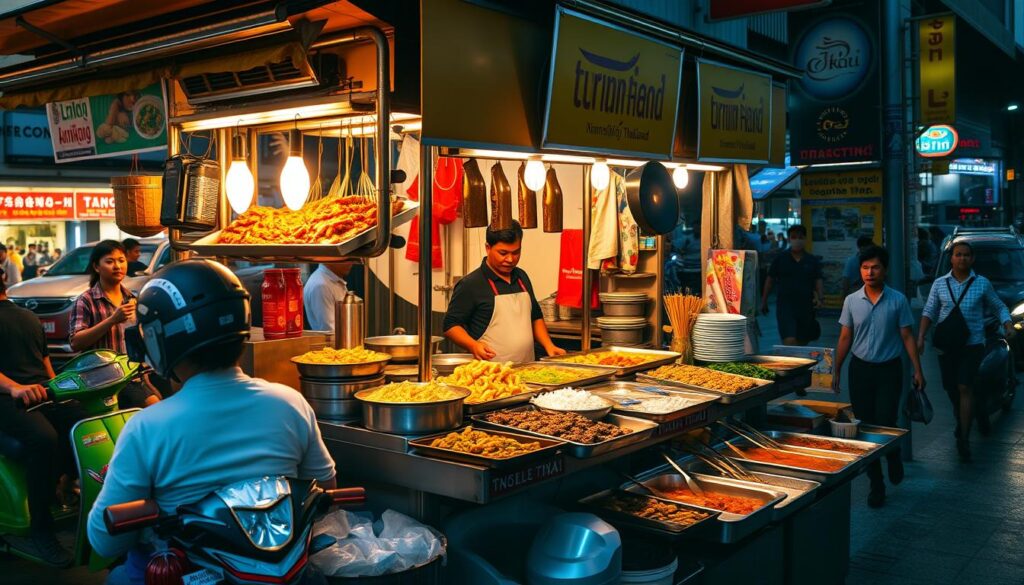
Street Food Tours: A Guided Experience
Guided tours are great for diving into Thai street food. These tours take you to the best spots, sharing local culture and cuisine. They often find hidden gems hard to discover alone.
On a street food tour, you’ll try many dishes and learn about their history and preparation. This experience deepens your appreciation for Thai cuisine and makes your food adventure richer.
Top Cities for Street Food Adventures
Thailand’s cities are famous for their street food. Bangkok, Chiang Mai, and Phuket are top spots for food lovers. Each city has its own flavors and specialties, making them essential for any street food journey.
- Bangkok: Known for its bustling streets and night markets, Bangkok offers a diverse range of street food options.
- Chiang Mai: This cultural hub is famous for its Khao Soi and other local delicacies.
- Phuket: The streets of Phuket are filled with a variety of seafood dishes and international cuisine.
Visiting these cities gives you a full street food experience. You’ll see the diversity and richness of Thai cuisine.
Tips for Eating Street Food Safely
To enjoy Thailand’s street food safely, follow these tips. Eating street food in Thailand can be a great experience. But, it’s important to choose the right vendors and food.
Look for Popular Vendors
Choosing popular vendors is a smart move. They have lots of customers, which means their food is fresh. Look for long queues or a busy atmosphere to find them. Choosing a vendor with a high volume of customers minimises the risk of foodborne illnesses.
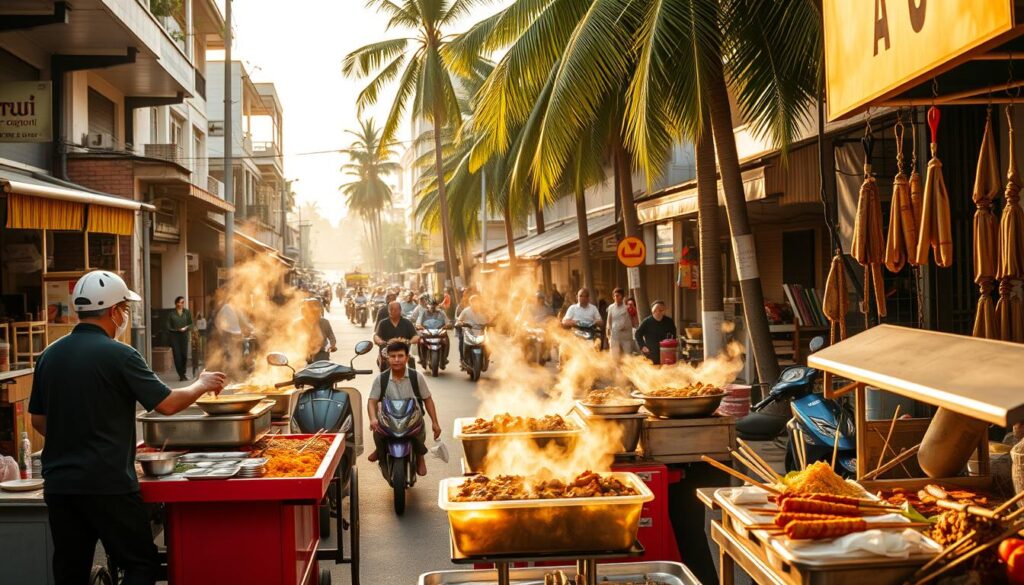
Signs of Fresh Ingredients
Fresh ingredients are key to good street food. Look for vibrant colours and fresh smells. Vendors who prepare ingredients in front of you are more likely to use fresh produce.
When to Avoid Certain Foods
While Thai street food is mostly safe, some foods are better avoided. Be cautious with raw or undercooked meat and foods left out too long. Being aware of these factors can significantly reduce your risk of getting sick.
By following these tips, you can enjoy Thai street food safely. A bit of caution ensures a great dining experience.
Understanding Thai Flavors and Spices
Exploring Thai street food means diving into its flavors and spices. Thai food is all about balance. It uses many ingredients to get that perfect taste.
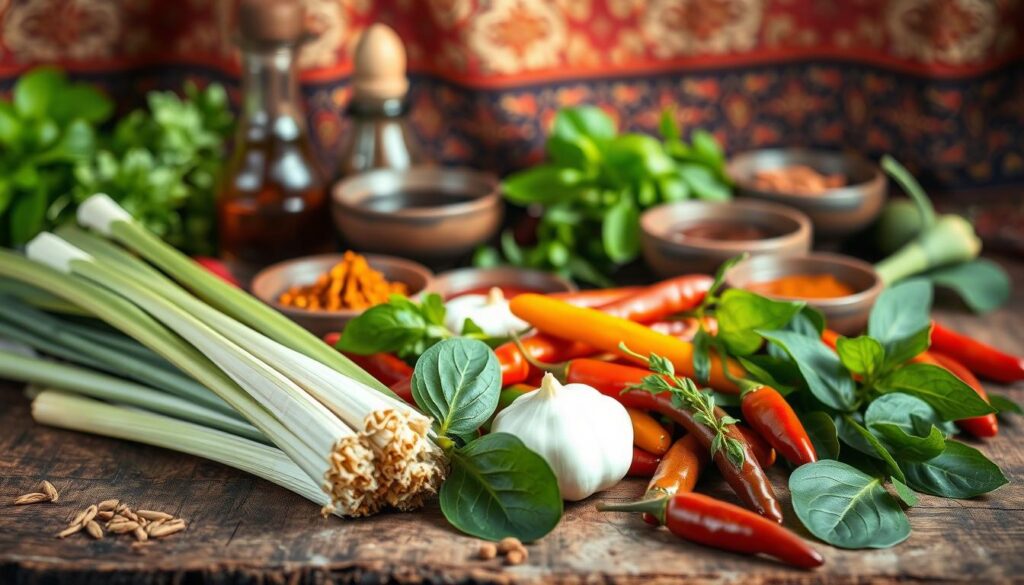
Common Ingredients in Thai Street Food
Thai street food is all about fresh stuff. You’ll find herbs like basil and cilantro, and spices like chilies and black pepper. Condiments like fish sauce and lime juice are also key.
Key ingredients include:
- Fish sauce, which adds a salty, umami flavor
- Lime juice, providing a sour and refreshing note
- Chilies, contributing a spicy kick
- Palm sugar, adding a touch of sweetness
The Balance of Sweet, Salty, and Spicy
Thai food is known for its sweet, salty, and spicy mix. This mix is what makes Thai dishes special. For instance, palm sugar’s sweetness can balance chili heat, while fish sauce adds depth.
Getting this balance right is key to enjoying Thai street food. As you try different dishes, notice how these flavors work together. It’s what makes Thai food so unique.
How Street Food Differs from Restaurant Food
Thai cuisine is unique, with a big difference between street food and dining in restaurants. Street food offers more than just food; it’s an experience.
Street food in Thailand is authentic and traditional. It’s made fresh right in front of you, using old family recipes. This makes it a true taste of Thai culture.
Authenticity and Tradition
Thai street food sticks to old recipes and cooking ways. Vendors are proud of their dishes, often using family secrets. This results in bold, balanced flavours.
Some top Thai street dishes include:
- Pad Thai: Stir-fried rice noodles with shrimp, tofu, and peanuts
- Som Tum: Spicy green papaya salad
- Moo Pad Krapow: Basil stir-fried pork
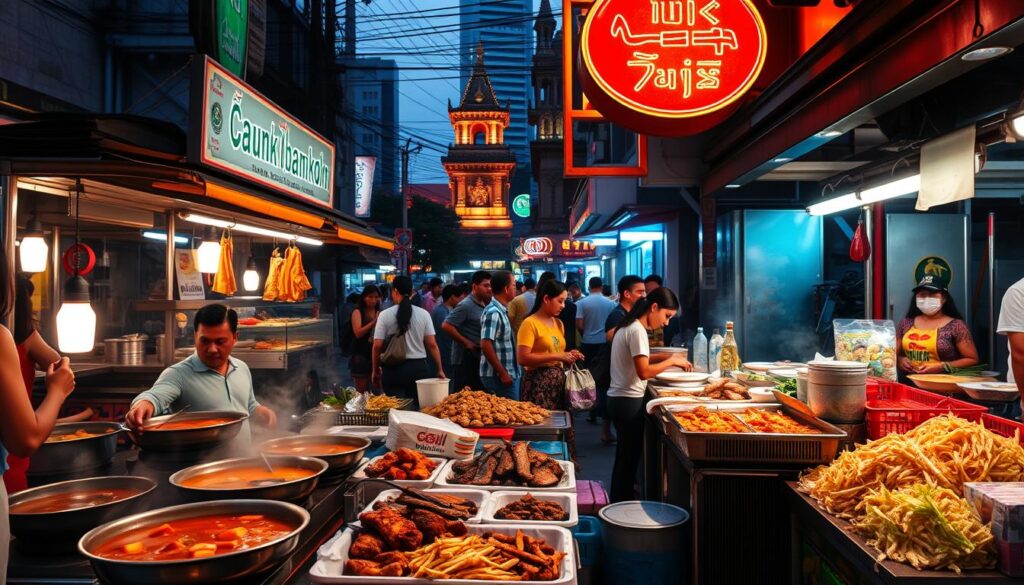
Pricing: Street Food vs. Fine Dining
Street food and restaurant food differ a lot in price. Street food is much cheaper. You can get a full meal for a small amount of money.
This makes street food great for all, locals and tourists alike. You can find amazing meals for under 100 THB (about 2.50 GBP). It’s perfect for trying real Thai food without spending a lot.
On the other hand, fine dining in Thailand costs more. It’s not just the food, but also the setting and service. While it’s a special experience, street food beats it in authenticity and value.
Unique Street Food Experiences in Thailand
Thailand’s night markets and food festivals are the heart of its street food scene. They offer a feast for the senses with their rich flavors and vibrant sights. You can try everything from classic Pad Thai to spicy Som Tum (green papaya salad).
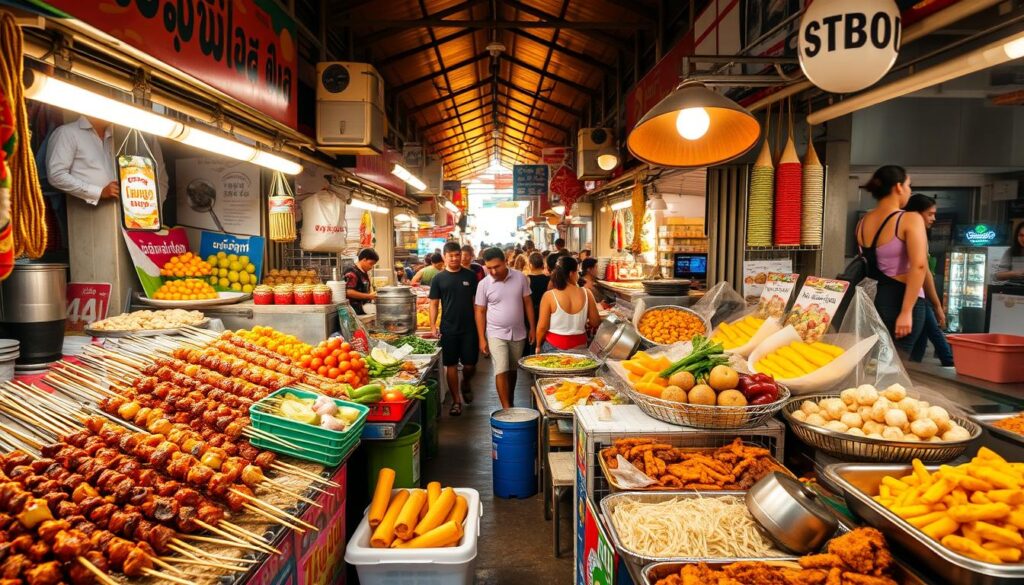
Night Markets: A Culinary Wonderland
Night markets in Thailand are a must-see for street food lovers. These lively markets have a wide range of dishes, all made fresh before your eyes. You can taste local treats like Moo Pad Krapow (basil stir-fried pork) and other special dishes from different regions.
The vibe is energetic, with vendors shouting out to people walking by. The smell of street food fills the air, making it a unique experience. It’s a mix of culture, food, and community all in one.
Food Festivals Celebrating Local Cuisine
Thailand’s food festivals are a big deal in the street food world. These events celebrate local food, bringing together vendors from all over. You can try a variety of dishes, from old favorites to new, creative ones.
Going to a food festival in Thailand is a great way to dive into the country’s street food culture. With festivals happening all year, you’re bound to find one that fits your travel schedule.
Vegetarian and Vegan Options in Thai Street Food
Thailand’s street food is great for everyone, not just meat-lovers. You can find lots of traditional Thai street food that’s vegetarian or vegan. Many dishes are already plant-based, or can be made to fit your diet.
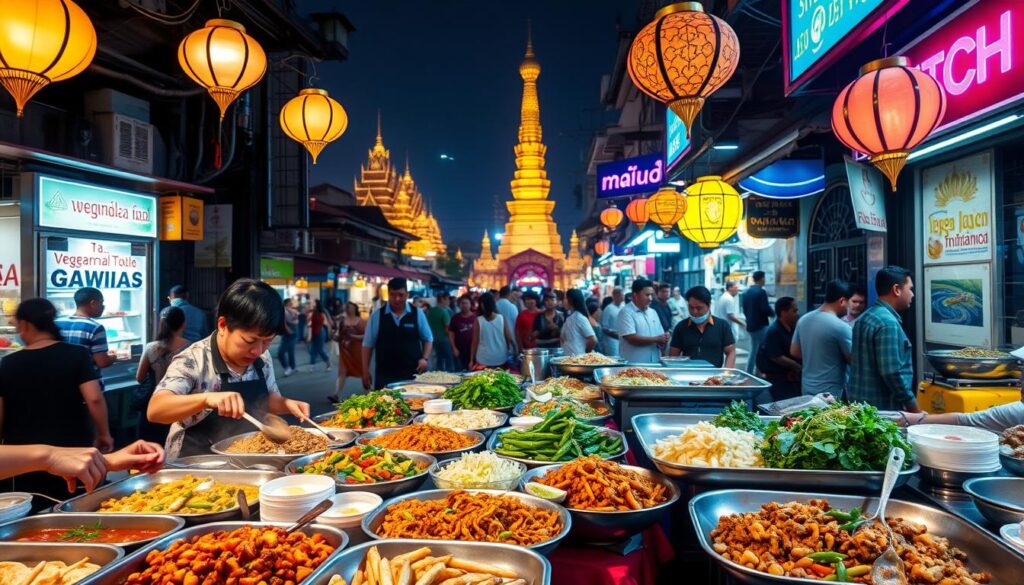
Popular Dishes for Plant-Based Eaters
Here are some must-try Thai street food dishes for those who don’t eat meat:
- Pad Thai (often made without meat, but check for fish sauce)
- Vegetable stir-fries with a variety of fresh vegetables
- Spicy papaya salad (Som Tum) without shrimp
- Grilled portobello mushrooms or other vegetarian skewers
- Massaman curry with vegetables or tofu
These dishes are tasty and show how varied Thai food can be. Many vendors will make sure your meal is right for you.
How to Communicate Dietary Preferences
Telling vendors about your diet in Thailand is easy. Knowing a few phrases helps a lot:
- “Mai gin kai” (ไม่กินไก่) means “I don’t eat chicken.”
- “Mai gin nuea” (ไม่กินเนื้อ) means “I don’t eat beef.”
- “Mai gin pla” (ไม่กินปลา) means “I don’t eat fish.”
- “Jet sao” (เจ) means “vegetarian.”
- “Mai gin nua mai gin kai” (ไม่กินเนื้อ ไม่กินไก่) means you don’t eat meat or chicken.
Knowing these phrases helps make sure your meal is what you want. It’s all about being clear when you order.
Street Food Etiquette: Do’s and Don’ts
Enjoying Thailand’s street food is more than just the taste. It’s about respecting vendors and local customs. As you visit the top street food spots in Thailand, being polite will make your experience better.
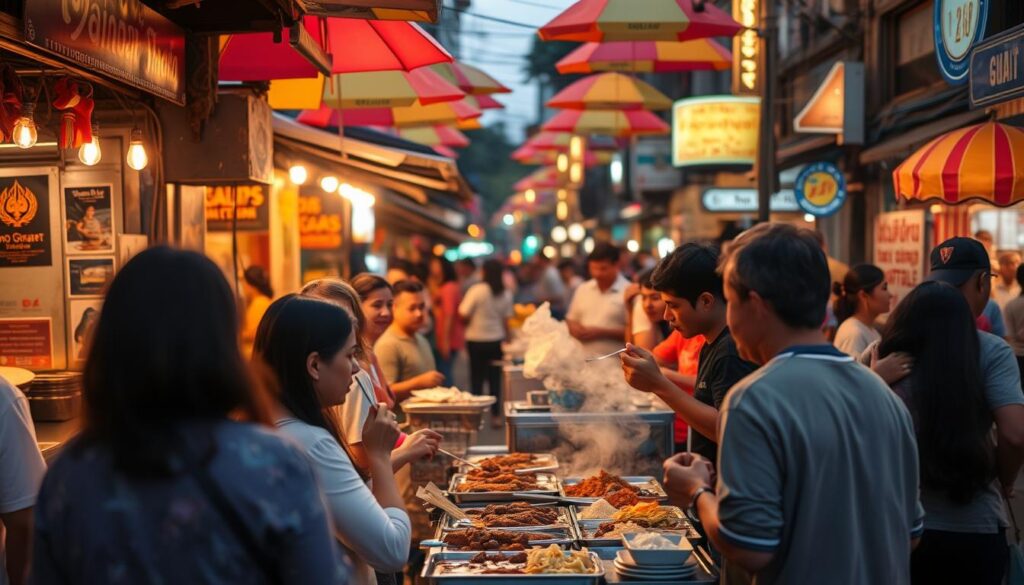
Respect for Vendors and Local Customs
When you talk to street food vendors, being respectful is key. Here are some tips:
- Greet vendors with a smile and a wai (a Thai greeting with your palms together).
- Be patient and wait for your turn; don’t push in front of others.
- Handle food gently, and avoid touching or tasting food that’s not yours.
Also, know that not finishing a meal can mean the food wasn’t good enough. It’s a local custom.
Tipping Practices in Thailand
Tipping in Thailand is not required but is nice for good service. Here are some tips:
- For street food vendors, a tip of 10-20 THB (about £0.25-£0.50) is polite.
- In restaurants, tipping around 10% of the total bill is common.
Remember, tipping shows you value good service. But it’s not expected. Being friendly and respectful to vendors will make your Thailand Street Food adventure great.
Preparing for a Street Food Adventure in Thailand
Getting ready for a food trip in Thailand is essential. Knowing a few key phrases can make your adventure better. It’s all about enjoying the real Thai street food.
Key Phrases and Cultural Insights
Learning basic Thai words like “sawatdee” (hello) and “khop khun krap” (thank you) is helpful. It lets you move around the busy streets with ease. You can also ask vendors about their famous dishes, like pad thai or som tum.
Packing Essentials for Street Food Explorers
For your trip, bring a water bottle to stay hydrated. Don’t forget a portable charger for your phone and cash for food. Hand sanitizer and wet wipes are good for keeping clean while eating on the move.
Staying Hydrated in the Thai Climate
Thailand’s hot weather is tough, so drink lots of water. Coconut water or other hydrating drinks at stalls are great. As you explore, remember to take breaks and pace yourself.
